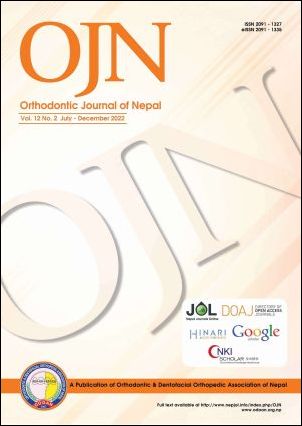Comparison of inter-radicular distance and buccal cortical bone thickness in Class I and Class II skeletal malocclusion patterns
DOI:
https://doi.org/10.3126/ojn.v12i2.51480Keywords:
Buccal cortical bone thickness, Cone Beam Computed Tomography (CBCT), Inter-radicular distance, MalocclusionAbstract
Introduction: Knowledge of the safe zone of mini-implant placement guides clinicians in choosing where to place mini-implants. Several studies evaluated the safe zone for mini-implants placement, but only a very few previous studies have taken different skeletal patterns into account when assessing measurements.
Objective: The purpose of this cross-sectional, comparative study was to compare the inter-radicular distance and buccal cortical bone thickness in Class I and Class II skeletal malocclusion patterns.
Materials and Methods: A total of 62 CBCT images of patients with Class I and Class II skeletal malocclusion were obtained from the records of the department of Oral medicine and Radiology, Kathmandu University Teaching Hospital. The inter-radicular distance and buccal cortical bone thickness were measured at four different heights (2, 4, 6 and 8 mm) from the CEJ towards the apex. These measurements were measured between different skeletal pattern and gender with independent t-test. The intergroup comparison at different height from CEJ was done with ANOVA
followed by Tukey's post-hoc test to see the difference within the category.
Result: There was a statistically significant difference observed in the inter-radicular distance between the maxillary first and second premolars at a height of 6 mm between Class I and Class II malocclusion patterns (p = 0.03). There were differences observed in the inter-radicular distance of the mandible at a different height based on skeletal malocclusion pattern, which was not statistically significant (p > 0.05). The buccal cortical bone thickness between the maxillary central and lateral incisors at the height of 2 mm from CEJ between Class I and Class II skeletal malocclusion patterns was statistically significant (p = 0.01). The buccal cortical bone thickness of the mandible at different heights based on skeletal malocclusion pattern there were differences observed which were not statistically significant (p > 0.05).
Conclusion: The inter-radicular distance and buccal cortical bone thickness could be influenced by different skeletal patterns and tend to increase from the CEJ to the apex in both Class I and Class II skeletal patterns.
Downloads
Downloads
Published
How to Cite
Issue
Section
License
Copyright (c) 2022 Orthodontic & Dentofacial Orthopedic Association of Nepal

This work is licensed under a Creative Commons Attribution 4.0 International License.
Copyright © held by Orthodontic & Dentofacial Orthopedic Association of Nepal
- Copyright on any research article is transferred in full to the Orthodontic & Dentofacial Orthopedic Association of Nepal upon publication in the journal. The copyright transfer includes the right to reproduce and distribute the article in any form of reproduction (printing, electronic media or any other form).
- Articles in the Orthodontic Journal of Nepal are Open Access articles published under the Creative Commons CC BY License (https://creativecommons.org/licenses/by/4.0/)
- This license permits use, distribution and reproduction in any medium, provided the original work is properly cited.




